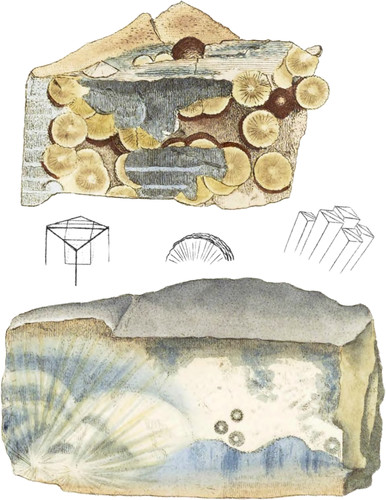 Enlarge
Enlarge
British Mineralogy
Hydrargillite
- Class 2. Earths.
- Order 1. Homogeneous.
- Gen. 1. Argil.
- Spec. 2. Hydrargillite.
- Div. 1. Crystallized.
- Spec. Char. Argil in combination with water.
- Syn.
- Hydrargillite. Davy in Phil. Trans.
- Wavellite. Babington in Mr. Davy’s Paper in Phil Trans.
According to our system, we of necessity differ from Dr. Babington in the name of this mineral. We venerate Dr. Wavell as an old acquaintance, and have little doubt but his name will be handed down to posterity as the first discoverer of this substance, near Barnstaple. Through having in my possession the valuable collection of W. Day, Esq., I have had specimens of it several years under the title of a Zeolite from Devonshire, and was going to figure it as such; but on examining and finding it a very doubtful Zeolite, I put it by for some future analysis or investigation. It happened, however, luckily to fall into the hands of Mr. Davy, who fully investigated it, and from the nature of its composition he very properly names it Hydrargillite (from ύδωρ water, and αργιλλος clay); and under so good an authority, we have little else to do than to quote a part of his paper from the Philosophical Transactions.
“The most common appearance is in hemisphærical groups of crystals” (on the surface of the gangue); “in some instances it exists as a collection of irregularly disposed prisms forming small veins in the stone: as yet I believe no insulated or distinct crystals have been found.” (My specimens terminate the radii outwardly, something like Sulphate of Barytes, and seem to be parts of a depressed octaëdron, sometimes a little truncated: see middle figures.) “Its colour is white in a few cases with a tinge of gray or green, and in some pieces (apparently beginning to decompose) of yellow. Its lustre is silky, some nearly opaque. Its texture is loose.” Our upper figure chiefly resembles this description. The lower figure has small dark circles, which seem to be the same substance with the margin darkest. Those larger spreading radii, which condense into white opaque circles with the help of smaller stellæ, terminate towards the ends.
The winter parts are small opaque clusters, in which the three darker ones are imbedded.
A similar substance has been found near Truro in Cornwall, which has been examined by the Rev. W. Gregor, of which I hope hereafter to give a figure.
| Alumine | 70 |
| Fluid | 26.2 |
| Lime | 1.4 |
| Loss | 2.4 |
| 100 |
Upon further examination we find it possible that the crystal may be derived from the cube, as we find the fracture perpendicular to the terminal faces of the right hand figure on a plane with the lengthened sides; and another parallel to the plane of the terminal face. I think I can with a magnifying lens discover a fracture on the sides. The column or prism is contrary to these faces, forming four sides, and there are two triangular faces set edgewise on the broader angle. We could not measure these faces, but hope that we may, some time or another, meet with larger crystals fit for that purpose. These faces are often somewhat rounded with a rusty sort of decomposition.

